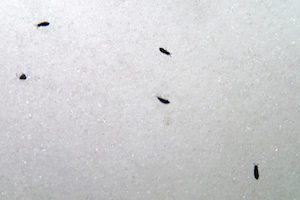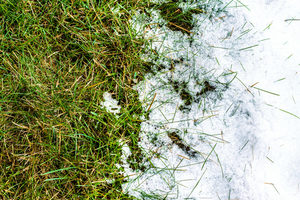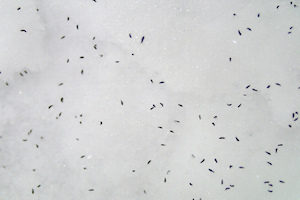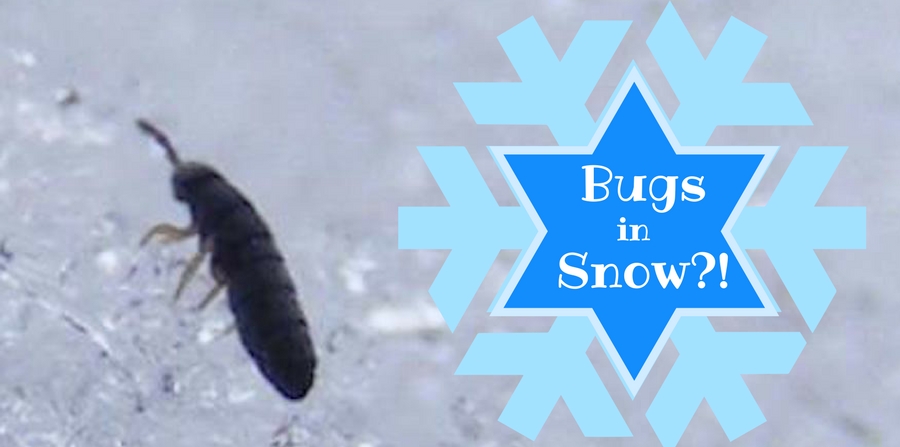Winter is a… divisive season. Chances are you either love it or hate it. Ok, chances are you either hate it or make up reasons to tolerate it (“It helps me appreciate the seasons,” etc.). Even if you’re firmly in camp “hate it”, however, you have to admit winter has its charms. Chief among these charms: you don’t have to worry about bugs! Or… *Pause for dramatic effect*… do you?
Imagine: You’re out walking your dog when you notice a cluster of weird black specs in the snow. You haven’t seen many horror movies, so you bend down to see what they are. Then they start jumping around! Yep, those things you just encountered are called “snow fleas”. Here’s everything you should know about them. It might not make you feel better, but at least you’ll be able to curse winter more accurately.
What Are They?
 The so-called “snow flea” isn’t actually a flea at all. They’re actually several species of arthropod springtails in the Collembola order. The most commonly encountered snow flea around here is probably Hypogastruna nivicola. There are about 700 species of springtails in North America, and they all share certain key characteristics.
The so-called “snow flea” isn’t actually a flea at all. They’re actually several species of arthropod springtails in the Collembola order. The most commonly encountered snow flea around here is probably Hypogastruna nivicola. There are about 700 species of springtails in North America, and they all share certain key characteristics.
Snow fleas are tiny and very skinny. The ones you encountered were probably only 1 to 2 millimeters long! They’re probably black, dark blue, or dark grey, though they can also be a yellow color. They can’t fly, but they can rapidly leap 3-4 inches using a spring-like body part called a “furcula”. The most upsetting thing about snow fleas is probably how abundant they can be. During winter and early spring, you might spot literally thousands of the tiny arthropods congregating on snow.
How Are They Alive?
Snow fleas are capable of synthesizing an antifreeze-like protein that keeps their bodies from freezing. They automatically begin producing this protein when temperatures dip beneath a certain threshold.
When temperatures warm up, the protein easily breaks down, allowing snow fleas to survive comfortably in all seasons. Other species can produce antifreeze-like substances, but only snow fleas produce one that breaks down easily in warmth. This antifreeze, combined with their easily-satisfied diet, makes it possible for snow fleas to survive winter without much effort. In fact, snow fleas have been called one of the hardiest animals ever!
What Do They Want?
 Despite their unusual habits and habitats, snow fleas want what pretty much all pests want. When they come out on warm winter days, they’re looking for food, water, and a chance to mate. Springtails provide an important service to their ecosystems by feeding on microscopic bacteria, algae, and fungi.
Despite their unusual habits and habitats, snow fleas want what pretty much all pests want. When they come out on warm winter days, they’re looking for food, water, and a chance to mate. Springtails provide an important service to their ecosystems by feeding on microscopic bacteria, algae, and fungi.
Along with food, snow fleas are attracted to moisture. The tiny arthropod is very sensitive to drying out, and requires a consistent source of moisture to survive. Springtails use a tube-like organ called a “collophore” to suck up water from the wet surfaces they crawl over. They may seek out melting snow on warm days to take in moisture. Finally, snow flea mating season is in early spring. When large numbers of snow flea congregate together, it’s usually to produce offspring.
Are They Dangerous?
Not at all. Snow fleas can’t bite or sting, nor can they damage plants, food products, property, or clothing. In fact, springtails like snow flies are some of the many garden arthropods that are considered beneficial.
By feeding on decaying organic matter and the bacteria it produces, snow fleas help garden plants grow in spring. An abundance of snow fleas in your yard can be considered a sign of healthy soil.
What Can I Do About Them?
 We’re lucky snow fleas are harmless, because there’s not really a good way to control them even if we wanted to. The springtail will never come indoors, so you don’t have to worry about infestations. They’re attracted to moisture and decaying plant life, both of which are difficult to prevent in winter and spring.
We’re lucky snow fleas are harmless, because there’s not really a good way to control them even if we wanted to. The springtail will never come indoors, so you don’t have to worry about infestations. They’re attracted to moisture and decaying plant life, both of which are difficult to prevent in winter and spring.
Even if you shoveled up all the snow in your yard, wet grass and dead plants would bring snow fleas calling anyway. In fact, springtail species are quite abundant all year. Snow fleas become more noticeable in winter because they come out of cover and stand out against snow. When all the snow melts as spring arrives, you’ll stop seeing snow fleas as frequently. Until then, don’t worry about them–they’re kind of cute anyway. Uh… right?
If you had to choose a bug to deal with in winter, you could do a lot worse than snow fleas. The diminutive arthropods are totally harmless, non-invasive, and content to stay away from you. At worst, all they’ll do is ruin your view of endless expanses of snow. And we don’t know about you, but we’re tired of looking at that anyway.
Even though pests largely take some time off every winter, that doesn’t mean your pest control should. There’s still plenty good year-round pest control can do for you this season. Remember: prevention is always more effective than treatment. If you need some pest prevention (or treatment!) this winter, give Griffin a call anytime. We’re always happy to brave the cold for you.


